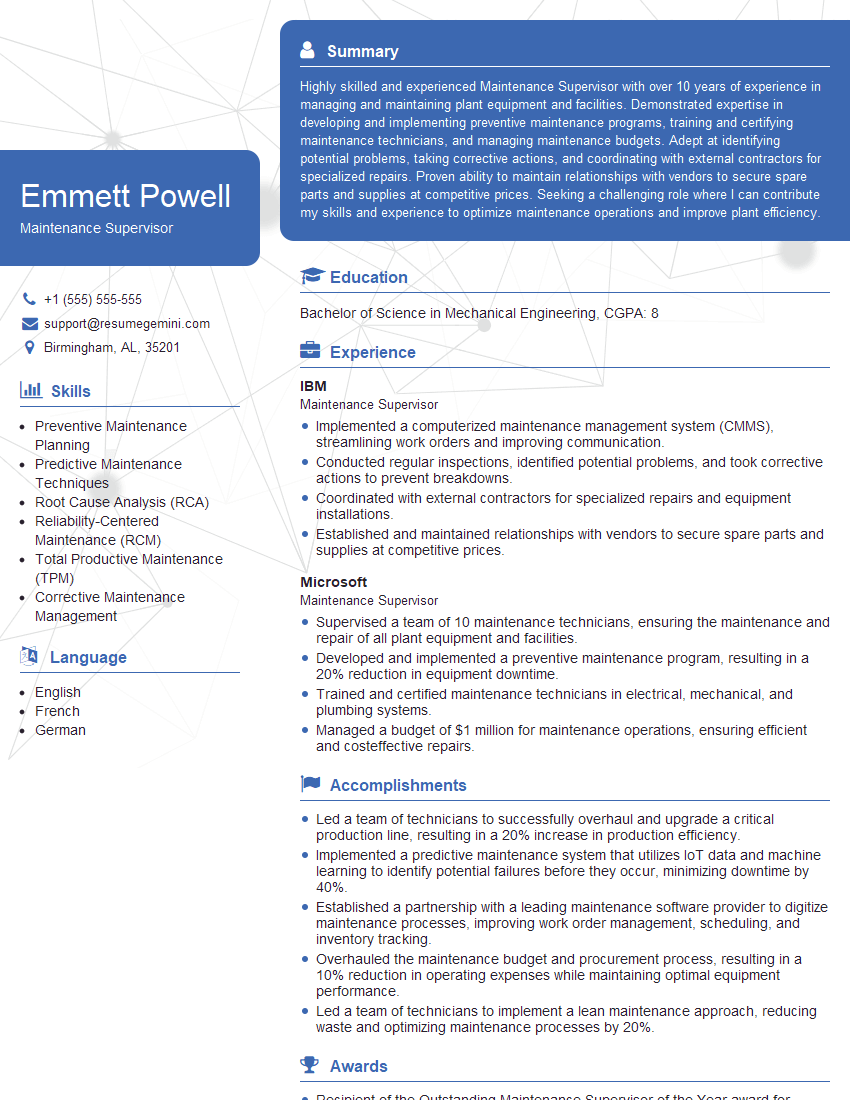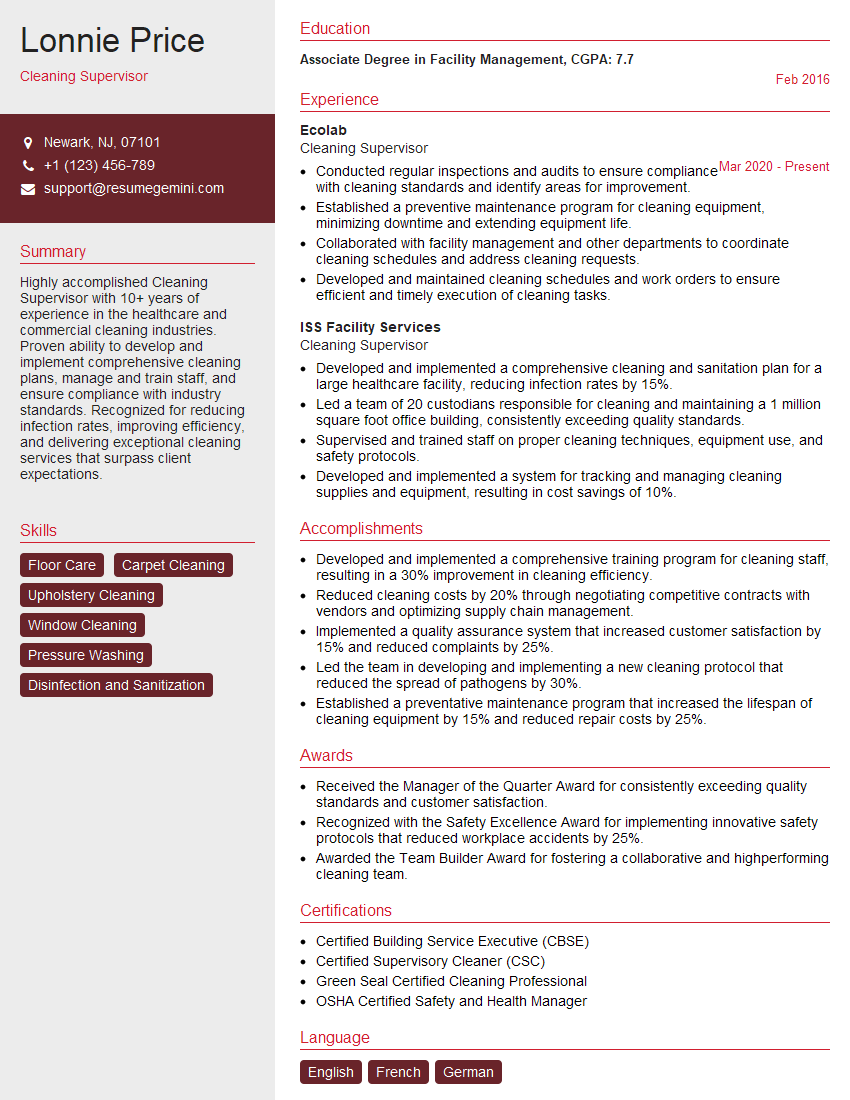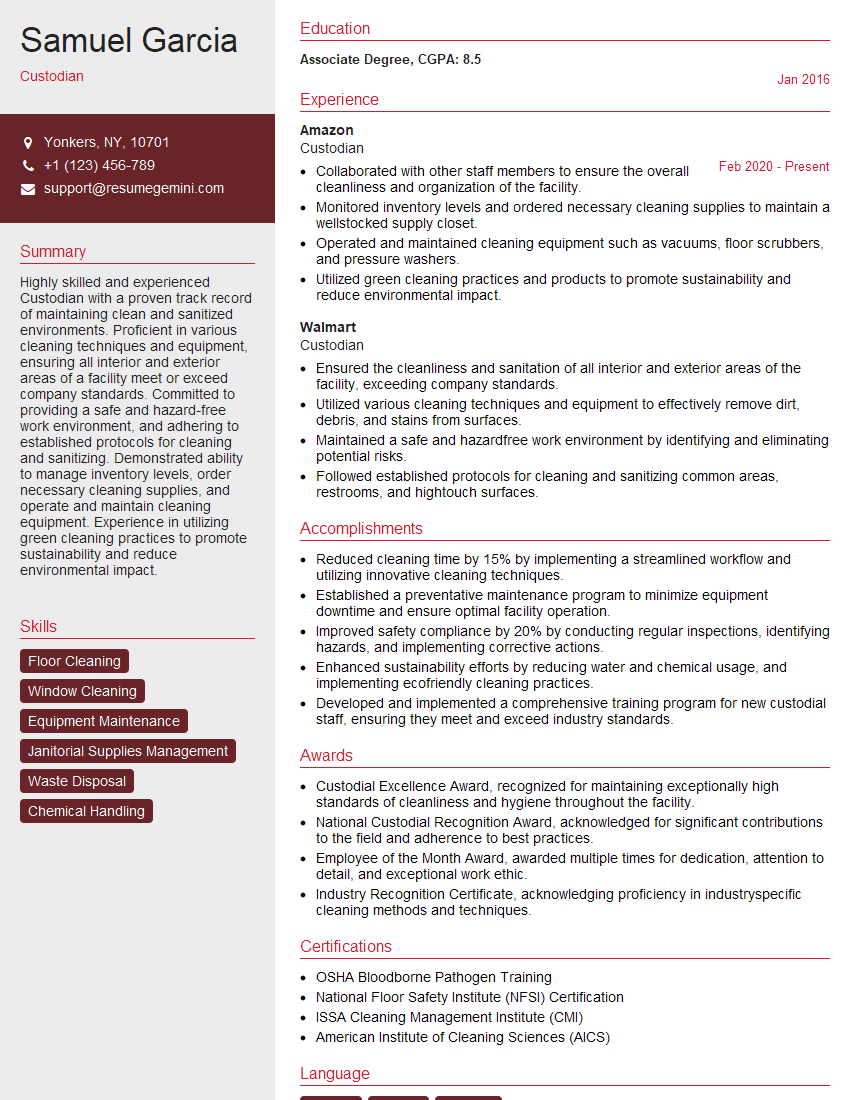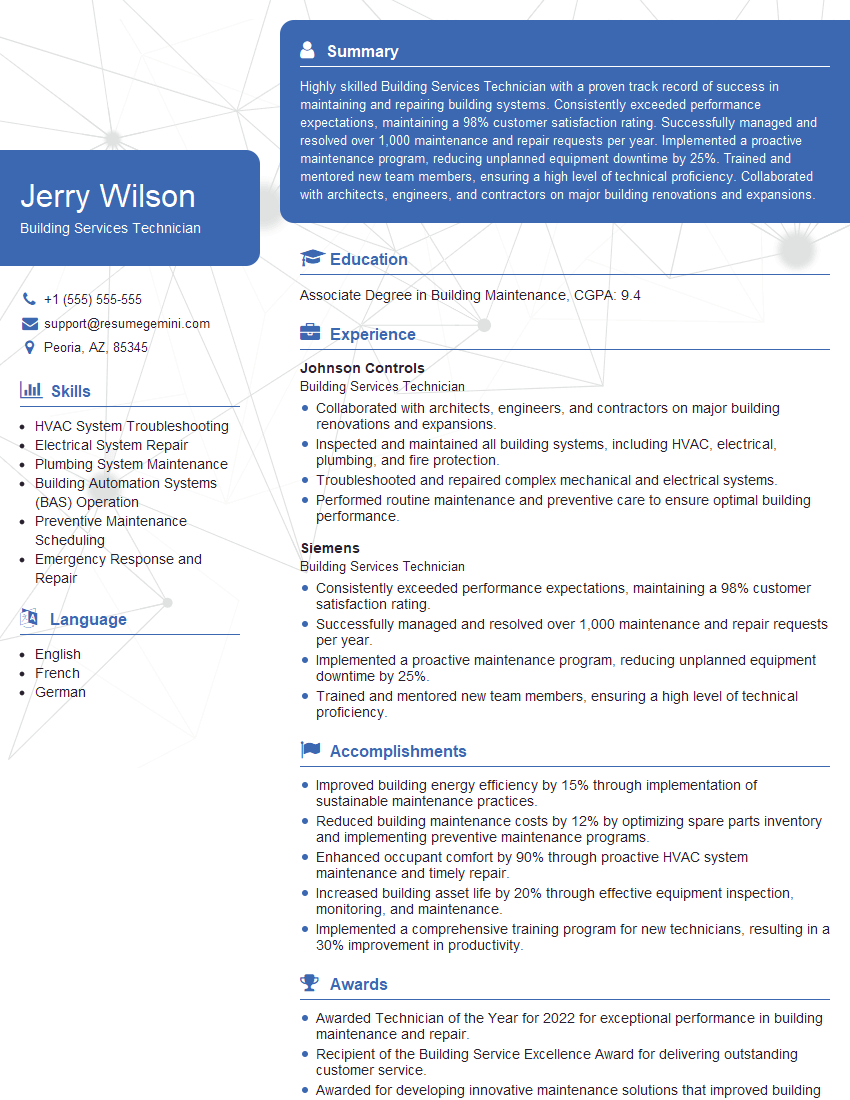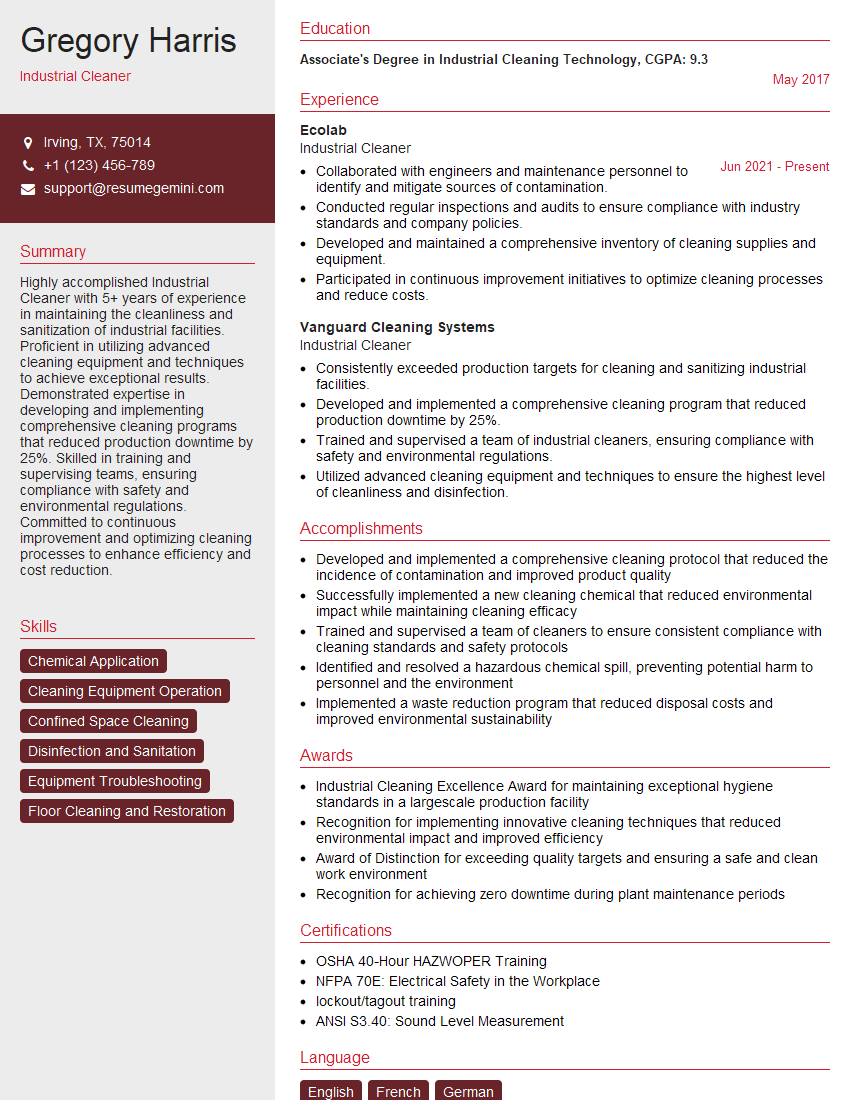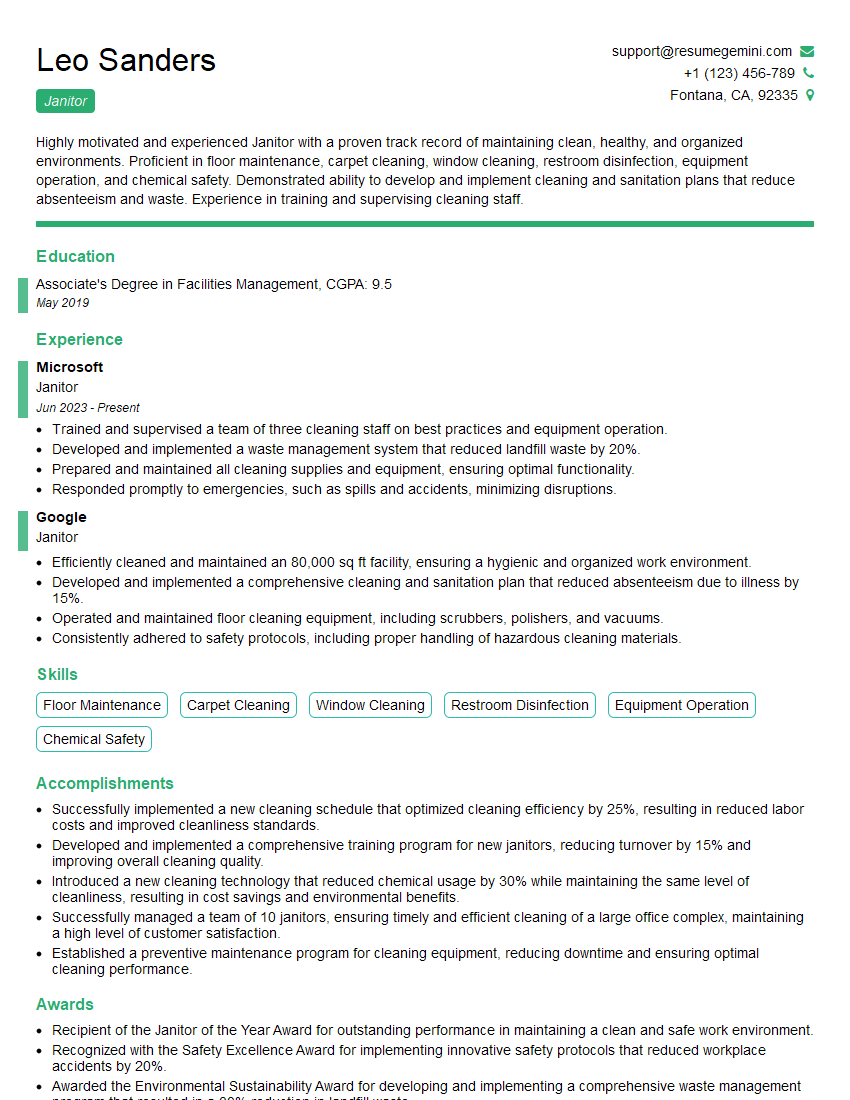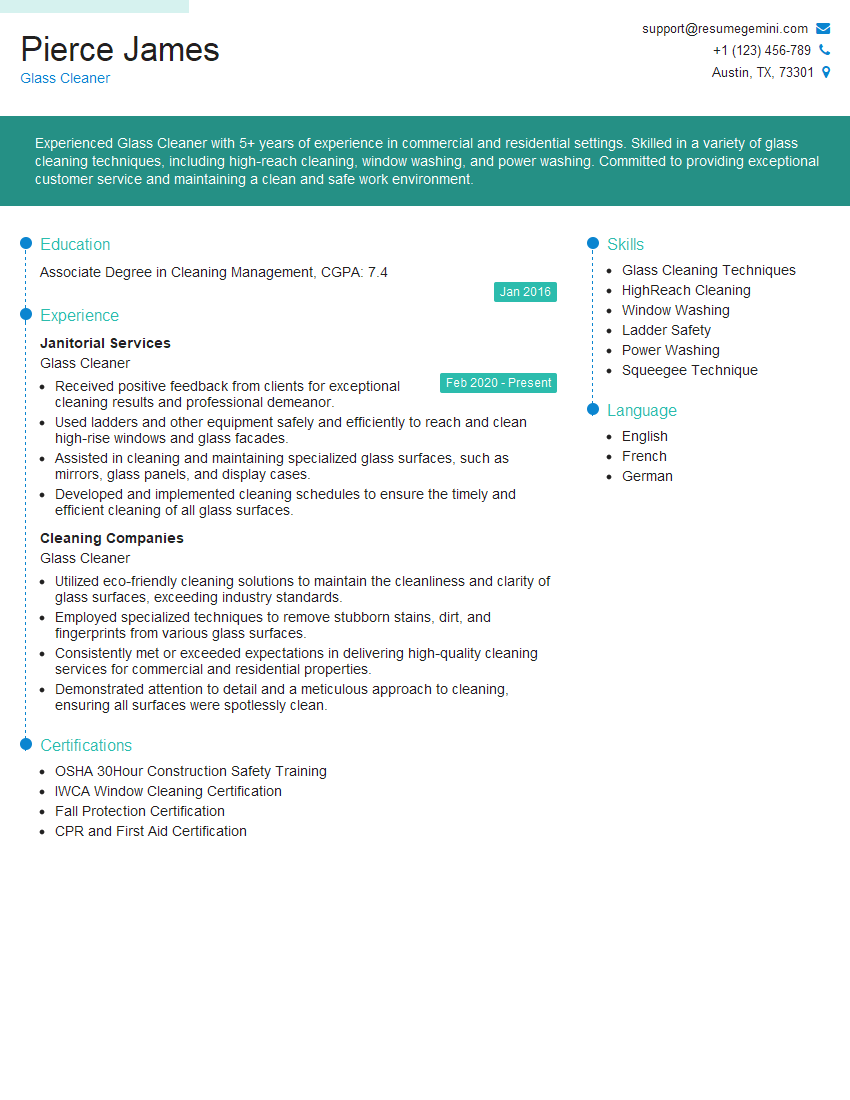Cracking a skill-specific interview, like one for Glass Cleaning and Maintenance, requires understanding the nuances of the role. In this blog, we present the questions you’re most likely to encounter, along with insights into how to answer them effectively. Let’s ensure you’re ready to make a strong impression.
Questions Asked in Glass Cleaning and Maintenance Interview
Q 1. What are the different types of glass cleaning solutions and when would you use each?
Glass cleaning solutions vary depending on the type of glass and the severity of the dirt. Here are a few common types:
- Basic Glass Cleaner: This is your everyday solution, usually a mixture of water, ammonia, and surfactants. It’s perfect for routine cleaning of most glass surfaces, like windows in a home or office.
- Specialized Glass Cleaners: For more stubborn dirt, grease, or grime, you might need a stronger cleaner. These often contain more powerful solvents and are best used for heavily soiled windows or mirrors.
- Acid-Based Cleaners (Use with Caution): These are reserved for extremely tough stains like hard water deposits or mineral build-up. They require careful handling and proper ventilation as they are highly corrosive. Always test in an inconspicuous area first.
- Distilled Water: For streak-free results, especially on high-quality glass, distilled water is essential. It lacks minerals that can leave behind residue. I often use distilled water as a final rinse.
The choice of cleaner depends heavily on the specific situation. For example, a basic glass cleaner will suffice for daily maintenance of a home’s interior windows, but a specialized cleaner with a degreasing agent might be necessary for a restaurant’s heavily soiled exterior windows facing a busy street.
Q 2. Describe your experience with various cleaning equipment (e.g., squeegees, ladders, lifts).
My experience with cleaning equipment is extensive. I’m proficient with various squeegees, from traditional rubber blades to the newer, more durable, and efficient ones with telescopic handles. I understand the importance of choosing the right blade for the job – softer blades for delicate surfaces and firmer blades for tougher soiling. I’ve used a variety of ladders, from lightweight aluminum step ladders for low-level work to heavier-duty extension ladders for higher reaches. Safety is paramount, so I’m always mindful of proper ladder setup and usage, including ensuring a stable base and extending the ladder far enough to avoid overreaching.
I’m also experienced with powered access equipment, such as boom lifts and scissor lifts. These are critical for safe and efficient high-rise window cleaning. I’m fully trained in operating these machines, understanding their limitations and ensuring all safety protocols are met before use. Proper harness use and regular equipment inspections are standard practice for me.
Q 3. How do you handle different types of glass surfaces (e.g., tinted, reflective, laminated)?
Different glass types require specific cleaning techniques. Tinted glass, for example, can be more susceptible to streaking, so extra care is needed during rinsing and drying. I usually opt for distilled water and a high-quality squeegee for a streak-free finish. Reflective glass requires a similar approach; the reflective nature makes streaks far more visible, so meticulous cleaning is crucial. Laminated glass is generally more durable, but aggressive scrubbing should be avoided as it could damage the lamination. A soft cloth and gentle pressure are key for this type of glass.
Before starting any cleaning job, I always assess the glass type and condition. A thorough inspection helps me select the right cleaning solutions and equipment, ensuring optimal results while minimizing any risk of damage.
Q 4. Explain your process for cleaning high-rise windows.
Cleaning high-rise windows is a multi-step process that demands precision and safety. My process typically involves the following steps:
- Planning & Assessment: A thorough site inspection is the first step. I determine the best access method (e.g., rope access, gondola, building-mounted platform), the condition of the glass, and any potential obstacles.
- Equipment Setup: All necessary safety equipment (harness, ropes, etc.) and cleaning tools are carefully checked and set up. I always work with a partner for safety and efficiency.
- Pre-Cleaning: Loosening any dirt or debris with a soft brush or water spray is important before applying any cleaning solutions.
- Cleaning: Using the chosen cleaning solution and tools, I thoroughly clean each panel, ensuring complete coverage.
- Rinsing & Drying: Thorough rinsing with distilled water is essential to remove any residue. A professional squeegee is used for efficient and streak-free drying.
- Inspection & Final Touches: A final inspection to check for any remaining dirt or streaks ensures a flawless finish.
Communication and teamwork are essential during high-rise cleaning. Regular communication with my partner and ground crew ensures safety and smooth operation.
Q 5. What safety precautions do you take while cleaning glass at heights?
Safety is my top priority when cleaning glass at heights. I always:
- Use appropriate safety equipment: This includes harnesses, ropes, safety lines, and fall arrest systems. These are inspected before each job.
- Follow all safety regulations: Strict adherence to local and company safety regulations is crucial.
- Work with a partner: Having a partner enhances safety and allows for mutual supervision and assistance.
- Use appropriate access equipment: Powered access equipment is chosen based on the height and the specific building’s access points.
- Regular safety checks: Equipment inspections, before and during the job, are non-negotiable to ensure everything is in good working order.
- Weather monitoring: I constantly monitor weather conditions and postpone the job if necessary (e.g., high winds, rain).
By adhering to these practices, I ensure my safety and the safety of those around me.
Q 6. How do you remove stubborn stains or marks from glass?
Removing stubborn stains requires a more tailored approach. For bird droppings, I might use a solution of water and a mild detergent, followed by thorough rinsing. For hard water stains, a diluted acid-based cleaner (used with extreme caution and appropriate ventilation) can be effective, but it’s crucial to test it on an inconspicuous area first. For paint splatters or other adhesive residues, a specialized glass cleaner designed to cut through grease and grime might be necessary. Sometimes, a razor blade scraper is used (very carefully!) to remove stubborn paint, but this requires a skilled touch to avoid scratching the glass.
The key is to identify the type of stain and choose the appropriate cleaning solution and method. Persistence and patience are often required, and working in stages is usually more successful than attempting a one-shot solution.
Q 7. Describe your experience with streak-free cleaning techniques.
Streak-free cleaning is an art that combines technique and the right tools. My approach hinges on several key factors:
- Using distilled water: Mineral deposits in tap water are a major cause of streaking. Distilled water eliminates this problem.
- Proper squeegee technique: Overlapping strokes and maintaining consistent pressure are crucial. I angle the squeegee blade correctly and consistently to ensure complete water removal.
- Clean squeegee blade: A clean blade is essential for a streak-free finish. I regularly wipe down the blade with a clean microfiber cloth.
- Appropriate cleaning solution: Using a low-residue cleaning solution minimizes the likelihood of streaking.
- Clean cloths: Microfiber cloths are crucial for streak-free wiping.
Practicing these techniques has enabled me to achieve consistently streak-free results, something clients often commend.
Q 8. How do you maintain the cleanliness of your equipment?
Maintaining clean equipment is paramount for delivering consistently high-quality glass cleaning. Think of your tools as extensions of your skill – if they’re dirty, your work will suffer. My routine involves a multi-step process after each job. First, I rinse all squeegees, mops, and microfiber cloths thoroughly with warm water to remove any lingering debris. Next, I use a specialized cleaning solution designed for glass cleaning equipment to eliminate any soap scum or chemical residue. This ensures that no streaks or residue are transferred to the next cleaning job. Finally, everything is allowed to air dry completely before being stored in a clean, dry location to prevent mold or mildew growth. For example, I dedicate specific buckets for rinsing and cleaning solutions, preventing cross-contamination. This meticulous cleaning prevents the spread of dirt and ensures the longevity of my tools.
Q 9. What are the common problems encountered while cleaning glass and how do you resolve them?
Common problems in glass cleaning range from stubborn streaks and water spots to ingrained dirt and even etching. Streaks often result from using too much cleaning solution, improper squeegee technique (like overlapping strokes incorrectly), or leaving residue. I address streaks by using a two-bucket system (one for cleaning solution, one for rinsing) and employing a proper squeegee technique with overlapping strokes from top to bottom. Water spots are usually caused by hard water; I counteract this with distilled water or a dedicated water spot remover. For ingrained dirt, a specialized glass cleaner, possibly with a pre-soaking step, is necessary. Etching, which is the permanent damage to the glass surface, requires more specialized techniques and is often beyond the scope of routine cleaning, potentially requiring professional glass restoration.
Q 10. How do you prioritize tasks when cleaning multiple windows or glass surfaces?
Prioritizing tasks when cleaning multiple windows or glass surfaces involves a strategic approach. I usually begin by assessing the overall condition of the glass. High-traffic areas, like entryways or storefront windows, often take precedence as they’re most visible and prone to more soiling. Next, I work from top to bottom and from left to right, ensuring a systematic and thorough approach, minimizing the risk of overlooking anything. For instance, if I’m cleaning a multi-story building, I’ll start at the top to prevent dripping onto already cleaned lower levels. This structured approach also maximizes efficiency, preventing wasted time and motion. I also consider factors such as access and safety before beginning. Prioritizing is not just about the speed of cleaning; it’s about ensuring a professional, thorough outcome.
Q 11. Explain your understanding of different cleaning chemicals and their safety procedures.
Understanding cleaning chemicals is crucial for effective and safe glass cleaning. I use a variety of solutions, each suited for specific purposes. Basic glass cleaners are formulated for everyday grime removal, while specialized cleaners target tough stains or water spots. For instance, some cleaners contain ammonia, while others are ammonia-free, catering to allergies or sensitivities. Safety procedures are paramount. I always read and follow the manufacturer’s instructions on dilution ratios and application methods. Proper ventilation is crucial, especially when using ammonia-based products, and I always wear appropriate personal protective equipment (PPE), including gloves and eye protection. Never mix different cleaning chemicals together, as this can create dangerous reactions. I store all chemicals securely and out of reach of children or pets. Safety isn’t just a rule; it’s a fundamental aspect of my professional practice.
Q 12. How do you handle spills or accidents while cleaning?
Handling spills or accidents promptly and safely is critical. If a cleaning solution spills, my first step is to immediately ventilate the area by opening windows or using a fan. Next, I use absorbent materials like paper towels or a clean mop to soak up the spill, avoiding spreading it. For larger spills or those involving hazardous chemicals, I’ll use appropriate protective gear and follow the specific cleanup instructions provided by the chemical manufacturer. If an accident involves breakage, I take precautions to avoid injury by carefully sweeping up any glass fragments, utilizing a dustpan and brush, and disposing of them responsibly in a puncture-resistant container. Thorough cleanup and appropriate safety measures are always my top priorities after any incident.
Q 13. What is your experience with specialized glass cleaning techniques (e.g., etching removal)?
My experience with specialized glass cleaning techniques, particularly etching removal, is limited to referring clients to specialized glass restoration professionals. While I can handle minor scratches or water spots, significant etching often requires professional intervention with specialized tools and techniques that are beyond the typical scope of window cleaning. Etching removal often involves polishing techniques using specialized compounds that require specialized training and equipment for safe and effective execution. Safety and the avoidance of causing further damage to the glass are paramount. Therefore, referring the client is crucial, ensuring optimal results and the avoidance of potential damage.
Q 14. Describe your experience with window film removal or application.
I have experience with both window film removal and application. Window film removal requires careful technique to prevent damage to the glass. I use a specialized film removal solution to soften the adhesive, followed by careful peeling and scraping. This process requires patience and precision, using tools like plastic scrapers to avoid scratching the underlying glass. Conversely, applying window film demands precision to avoid air bubbles or wrinkles. This involves careful measurement, cleaning the glass surface thoroughly, and applying the film using a squeegee to remove air pockets. Both tasks demand attention to detail and a strong understanding of the materials and techniques involved. For very complex installations or removals, I would coordinate with a specialized film installation professional to ensure a top-quality outcome.
Q 15. How do you identify and address potential damage to glass surfaces?
Identifying potential damage to glass surfaces requires a keen eye and methodical approach. I begin by visually inspecting the glass for any obvious signs of damage like cracks, chips, scratches, or pitting. I pay close attention to the edges, as these are often more vulnerable. For less obvious damage, I might use a strong light source at a low angle to highlight any imperfections.
Addressing the damage depends on its severity and location. Minor scratches might be buffed out with specialized glass polishing compounds. For larger cracks or chips, the glass may need to be replaced entirely, especially if it compromises structural integrity. In the case of etching or pitting from corrosive substances, professional restoration might be needed. I always document the damage with photos before and after any intervention, providing detailed records for the client.
For example, I once discovered a hairline fracture in a large storefront window during a routine cleaning. Luckily, it was caught early, and we were able to prevent further damage by recommending immediate repair instead of risking further breakage during cleaning.
Career Expert Tips:
- Ace those interviews! Prepare effectively by reviewing the Top 50 Most Common Interview Questions on ResumeGemini.
- Navigate your job search with confidence! Explore a wide range of Career Tips on ResumeGemini. Learn about common challenges and recommendations to overcome them.
- Craft the perfect resume! Master the Art of Resume Writing with ResumeGemini’s guide. Showcase your unique qualifications and achievements effectively.
- Don’t miss out on holiday savings! Build your dream resume with ResumeGemini’s ATS optimized templates.
Q 16. What is your experience working with different types of window frames and materials?
My experience encompasses a wide range of window frames and materials. I’m proficient in cleaning windows with aluminum, wood, vinyl, fiberglass, and steel frames. Each material requires a slightly different approach. For example, wood frames are more delicate and require gentler cleaning solutions to avoid damage or discoloration. Aluminum frames, on the other hand, are generally more durable and can withstand harsher cleaning methods. I’m also familiar with different glazing types, including single, double, and triple-paned windows, and understand the importance of using appropriate cleaning techniques to avoid damaging the seals or causing condensation issues.
Working with historic buildings, for instance, often involves unique frame materials like ornate wrought iron or intricately carved wood, requiring specialized cleaning solutions and techniques to preserve their historical integrity. Understanding the material’s properties is key to achieving a thorough and safe cleaning.
Q 17. How do you determine the appropriate cleaning method for different types of glass?
Choosing the right cleaning method depends on several factors: the type of glass (e.g., regular window glass, tempered glass, laminated glass), the level of soiling, and the presence of any coatings or films (like low-E coatings).
For regular window glass with light soiling, a simple solution of warm water and a mild detergent is often sufficient. Heavier soiling might require a stronger cleaner or pre-treatment with a specialized degreaser. For delicate surfaces or glass with specialized coatings, I would always opt for a non-abrasive cleaner and a soft microfiber cloth to prevent scratches. I avoid using abrasive cleaners, scouring pads, or ammonia-based products, as they can damage the glass surface. Tempered glass, often found in shower doors and some windows, is more durable than regular glass, but it still needs careful handling to avoid scratching.
For example, I’d use a different cleaning approach for cleaning a delicate antique mirror versus a heavily soiled industrial window. The antique mirror would receive a gentle cleaning with distilled water and a soft brush, while the industrial window might benefit from a pressure washer (used cautiously) followed by a streak-free cleaning.
Q 18. Explain your experience managing a team or supervising cleaning tasks.
I’ve managed teams ranging from two to eight cleaning personnel, overseeing both residential and commercial projects. My management style emphasizes clear communication, effective delegation, and on-site training. I create detailed cleaning schedules, assigning tasks based on individual skills and experience. Regular check-ins ensure everyone stays on track and any issues are addressed promptly. I also foster a team environment where open communication and collaboration are valued.
For instance, when managing a large commercial building cleaning, I created a detailed checklist for each team member, ensuring consistency across all areas. I also implemented a system for reporting any damaged equipment or safety concerns, allowing for proactive problem-solving and prevention of further issues.
Q 19. What is your experience using specialized cleaning tools (e.g., reach and wash systems)?
I have extensive experience using specialized cleaning tools, including reach and wash systems (also known as water-fed pole systems). These systems utilize purified water to clean windows from the ground, eliminating the need for ladders or lifts in many cases. This significantly improves safety and efficiency, particularly for high-rise buildings. I’m proficient in operating various types of poles, brushes, and water filtration systems. I also have experience with other specialized equipment such as window vacuum systems, squeegees of various sizes, and specialized cleaning solutions designed for specific types of glass and frames. Regular maintenance and inspections of this equipment are crucial to ensuring its optimal performance and safety.
The reach and wash system, for example, significantly reduced the time it took to clean the exterior windows of a five-story building, while dramatically improving safety by eliminating the need for risky ladder work.
Q 20. How do you ensure the safety of the work area during glass cleaning operations?
Safety is paramount in glass cleaning. Before any cleaning operation, I conduct a thorough risk assessment. This includes identifying potential hazards, such as unstable surfaces, electrical lines, and hazardous materials. I always use appropriate safety equipment, including harnesses, safety lines, and fall protection when working at heights. For ground-level work, I ensure the area is clear of obstructions and use appropriate warning signs to prevent accidents. I also educate my team members on safe work practices and ensure that they always follow safety protocols.
For example, when cleaning windows on a high-rise building, I use a comprehensive safety plan that includes regular equipment checks, harness inspections, and clear communication between team members. I always adhere to the strictest safety regulations and never compromise safety for speed.
Q 21. Describe your experience with preventative maintenance for glass surfaces.
Preventative maintenance is key to keeping glass surfaces clean and damage-free. This includes regular cleaning, using appropriate cleaning solutions and techniques, and addressing minor issues promptly. It also involves protecting the glass from environmental factors such as dust, bird droppings, and harsh weather conditions. Regular inspections can help identify potential problems early on, preventing them from becoming major issues. This might include applying protective coatings, regularly cleaning window tracks, and addressing any minor damage to the glass immediately.
For example, recommending the installation of window screens to prevent bird droppings from accumulating or suggesting the use of a protective film to reduce UV damage are part of a preventative maintenance strategy. By proactively addressing potential issues, we minimize the risk of major repairs and maintain the longevity and aesthetic appeal of the glass.
Q 22. How do you handle customer complaints or concerns regarding glass cleaning?
Handling customer complaints about glass cleaning starts with active listening and empathy. I always begin by letting the customer fully explain their concern, ensuring I understand their perspective completely. Then, I calmly and professionally explain the process we follow, highlighting the steps taken to achieve a streak-free finish. For example, if a customer mentions streaks, I’d explain our multi-step process: pre-cleaning to remove debris, application of specialized cleaning solution, meticulous wiping with microfiber cloths, and finally, a quality check.
If the issue is valid, I apologize sincerely and offer a solution, such as a re-clean of the affected area or a partial refund, depending on the situation. I always aim for a resolution that leaves the customer feeling valued and satisfied. Documentation of the complaint and resolution is crucial for continuous improvement of our service.
For example, once a customer complained about persistent water spots on their large window. After careful inspection, I discovered the issue was due to hard water. I explained the situation, suggesting a pre-treatment with a water spot remover before the standard cleaning process. This addressed the root cause, prevented future problems, and pleased the customer.
Q 23. What is your understanding of environmental regulations concerning cleaning solutions?
My understanding of environmental regulations concerning cleaning solutions is comprehensive. I’m well-versed in local, state, and federal regulations regarding the disposal of hazardous waste, including certain cleaning chemicals. I prioritize the use of environmentally friendly, biodegradable cleaning solutions whenever possible. This not only reduces our environmental impact but also aligns with many clients’ sustainability goals.
I’m familiar with the proper labeling, storage, and handling of chemicals to ensure worker safety and compliance. This includes understanding SDS (Safety Data Sheets) for each product used and following all safety precautions meticulously. For instance, I know that certain solvents are restricted or require special disposal procedures, and I always follow these guidelines precisely. Using microfiber cloths instead of paper towels reduces waste significantly, contributing to a greener cleaning approach.
Q 24. How do you assess the risk of cleaning high-risk areas?
Assessing the risk of cleaning high-risk areas, such as high windows or precarious ledges, involves a thorough risk assessment before commencing work. This includes carefully inspecting the area for potential hazards like loose materials, fragile surfaces, or unstable structures.
The next step is to determine the necessary safety equipment. This might include harnesses, safety lanyards, fall arrest systems, and proper footwear. I always verify that the equipment is in good working order and appropriately used. I also consider the weather conditions. High winds, rain, or ice significantly increase the risk and may necessitate postponing the cleaning until conditions improve.
Furthermore, I never work alone in high-risk environments. A spotter is always present to ensure safety and assist in case of an emergency. Regular training and refresher courses on safety protocols are essential for maintaining expertise and minimizing risk.
Q 25. What is your knowledge of different glass types and their unique cleaning requirements?
My knowledge of various glass types and their specific cleaning requirements is extensive. Different glass types react differently to cleaning solutions and techniques. For instance, antique or stained glass requires a more delicate approach, using gentler cleaning solutions and avoiding abrasive materials to prevent damage. Laminated glass, common in car windshields, is more resistant to scratches but needs careful handling to avoid damaging the layers.
Modern glass, such as tempered glass in shower doors, is very durable, but aggressive cleaning agents can still cause etching over time. Knowing the type of glass allows me to choose appropriate cleaning products and techniques, maximizing cleaning effectiveness while protecting the glass’s integrity. For example, I’d use a specialized cleaner for antique glass, focusing on gentle wiping and avoiding harsh scrubbing. For modern glass, I might choose a more powerful cleaner, but always apply it according to manufacturer instructions.
Q 26. How do you handle difficult situations or unexpected challenges during cleaning?
Handling unexpected challenges during cleaning requires adaptability and problem-solving skills. For example, if I encounter a stubborn stain that resists standard cleaning methods, I systematically try different approaches. This might include using a specialized stain remover, a different type of cleaning cloth, or a slightly more aggressive (yet still safe) cleaning technique. I always thoroughly document the issue and the attempted solutions, for future reference.
In situations involving broken glass, my immediate priority is safety. I secure the area, prevent further breakage, and dispose of the broken glass properly, adhering to all safety regulations. If unforeseen circumstances, such as inclement weather or equipment malfunction, interfere with the job, my first step is to assess the situation, communicate clearly with the client, and develop a contingency plan to minimize disruptions. My proactive approach ensures that I can overcome obstacles efficiently and effectively, maintaining a high level of service.
Q 27. Describe your experience with inventory management and ordering cleaning supplies.
My experience with inventory management and ordering cleaning supplies involves meticulous tracking of stock levels. I use a combination of digital inventory management systems and physical stock checks to maintain an accurate record of supplies. This allows me to anticipate needs and place orders efficiently, preventing shortages that could disrupt our cleaning schedules.
I work closely with suppliers to ensure timely delivery and competitive pricing. I negotiate contracts that offer favorable terms and discounts for bulk purchases, optimizing costs while maintaining a consistent supply of high-quality materials. My focus is on using environmentally conscious products, and I prioritize suppliers that share these values.
Q 28. What are your salary expectations for this role?
My salary expectations for this role are commensurate with my experience, skills, and the responsibilities involved. Considering my extensive knowledge of glass cleaning, my proven track record of exceeding client expectations, and my commitment to providing exceptional service, I am seeking a salary in the range of [Insert Salary Range] annually. This is based on my research of similar roles in the industry and aligns with my experience and expertise. I am open to discussing this further and am confident that my contributions would provide significant value to your organization.
Key Topics to Learn for Glass Cleaning and Maintenance Interview
- Understanding Different Glass Types: Learn to identify various glass types (e.g., tempered, laminated, coated) and their specific cleaning requirements. This includes understanding the potential damage caused by improper cleaning techniques.
- Cleaning Techniques and Methods: Master different cleaning methods, including streak-free wiping, squeegee techniques, and the use of various cleaning solutions. Practice applying these techniques in different scenarios (e.g., high-rise windows, delicate glass surfaces).
- Cleaning Solutions and Chemicals: Familiarize yourself with the appropriate cleaning agents for different types of glass and dirt. Understand the safety procedures and precautions associated with handling chemicals. Know how to mix solutions correctly and safely.
- Equipment and Tool Usage: Learn to safely and effectively operate various cleaning equipment, including ladders, lifts, squeegees, window washing poles, and specialized cleaning tools. Discuss maintenance of these tools.
- Safety Procedures and Regulations: Demonstrate knowledge of workplace safety regulations related to heights, chemical handling, and personal protective equipment (PPE). Be prepared to discuss risk assessment and prevention methods.
- Maintenance and Prevention: Understand preventative maintenance strategies for reducing the frequency of cleaning and extending the lifespan of glass surfaces. Discuss identifying and addressing potential issues like water damage or sealant failure.
- Problem-Solving and Troubleshooting: Be ready to discuss how you would approach common problems, such as stubborn stains, difficult-to-reach areas, or damaged glass. Explain your problem-solving approach and ability to adapt to different situations.
Next Steps
Mastering glass cleaning and maintenance opens doors to a rewarding career with opportunities for advancement and specialization. A strong resume is key to showcasing your skills and experience effectively. To increase your chances of landing your dream job, create an ATS-friendly resume that highlights your expertise in this field. ResumeGemini is a trusted resource to help you build a professional and impactful resume. Examples of resumes tailored to Glass Cleaning and Maintenance are available to guide you.
Explore more articles
Users Rating of Our Blogs
Share Your Experience
We value your feedback! Please rate our content and share your thoughts (optional).
What Readers Say About Our Blog
Hey interviewgemini.com, just wanted to follow up on my last email.
We just launched Call the Monster, an parenting app that lets you summon friendly ‘monsters’ kids actually listen to.
We’re also running a giveaway for everyone who downloads the app. Since it’s brand new, there aren’t many users yet, which means you’ve got a much better chance of winning some great prizes.
You can check it out here: https://bit.ly/callamonsterapp
Or follow us on Instagram: https://www.instagram.com/callamonsterapp
Thanks,
Ryan
CEO – Call the Monster App
Hey interviewgemini.com, I saw your website and love your approach.
I just want this to look like spam email, but want to share something important to you. We just launched Call the Monster, a parenting app that lets you summon friendly ‘monsters’ kids actually listen to.
Parents are loving it for calming chaos before bedtime. Thought you might want to try it: https://bit.ly/callamonsterapp or just follow our fun monster lore on Instagram: https://www.instagram.com/callamonsterapp
Thanks,
Ryan
CEO – Call A Monster APP
To the interviewgemini.com Owner.
Dear interviewgemini.com Webmaster!
Hi interviewgemini.com Webmaster!
Dear interviewgemini.com Webmaster!
excellent
Hello,
We found issues with your domain’s email setup that may be sending your messages to spam or blocking them completely. InboxShield Mini shows you how to fix it in minutes — no tech skills required.
Scan your domain now for details: https://inboxshield-mini.com/
— Adam @ InboxShield Mini
Reply STOP to unsubscribe
Hi, are you owner of interviewgemini.com? What if I told you I could help you find extra time in your schedule, reconnect with leads you didn’t even realize you missed, and bring in more “I want to work with you” conversations, without increasing your ad spend or hiring a full-time employee?
All with a flexible, budget-friendly service that could easily pay for itself. Sounds good?
Would it be nice to jump on a quick 10-minute call so I can show you exactly how we make this work?
Best,
Hapei
Marketing Director
Hey, I know you’re the owner of interviewgemini.com. I’ll be quick.
Fundraising for your business is tough and time-consuming. We make it easier by guaranteeing two private investor meetings each month, for six months. No demos, no pitch events – just direct introductions to active investors matched to your startup.
If youR17;re raising, this could help you build real momentum. Want me to send more info?
Hi, I represent an SEO company that specialises in getting you AI citations and higher rankings on Google. I’d like to offer you a 100% free SEO audit for your website. Would you be interested?
Hi, I represent an SEO company that specialises in getting you AI citations and higher rankings on Google. I’d like to offer you a 100% free SEO audit for your website. Would you be interested?
good
